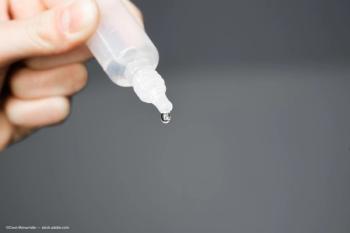
Tracking treatment adherence in newly diagnosed open-angle glaucoma
An analysis of U.S. claims data reveals a substantial proportion of patients (17%) remained untreated 4 years after their initial diagnosis of open-angle glaucoma.
Reviewed by Gail F. Schwartz, MD
Dr. SchwartzA significant number of patients (17%) remained untreated 4 years after their initial open-angle glaucoma (OAG) diagnosis, according to U.S. claims data that follow the prescription of IOP-lowering medications and performance of glaucoma procedures.
“For this patient population, IOP-lowering eye drops are the most common initial therapy for OAG,” said Gail F. Schwartz, MD. “The availability of ophthalmic fixed combinations has simplified topical dosing regimens for many patients.
More:
“For selected patients, laser trabeculoplasty is frequently an alternative first-line treatment,” added Dr. Schwartz, who is in private practice and assistant professor, Wilmer Eye Institute, Johns Hopkins University School of Medicine, Baltimore.
Despite this, there is little known about the treatment numbers and their sequence and timing used to manage these patients. Having this information available would facilitate more accurate assessment of the patient burden and the unmet need for innovative therapies, she noted.
Related:
Considering the need for specific prescribing data, she and her colleagues conducted a retrospective claims analysis using the Truven Marketscan Commercial Claims and Medicare Supplemental databases that covered July 2007 to December 2014.
Patients were included if they had a minimum of two diagnoses of OAG 7 or more days apart and within 1 year, with the first diagnosis in 2010; 30 or more months of continuous enrollment before the index diagnosis with no OAG diagnosis or OAG medication (unless with an accompanying pre-index ocular hypertension diagnosis); and 48 or more months of continuous enrollment after the index diagnosis.
During the 4-year study period, investigators evaluated the use of glaucoma medications and the procedures performed, the time from diagnosis to first therapy with medication or laser trabeculoplasty, the sequence of therapies implemented, and the use of adjunctive medications after laser trabeculoplasty.
Recent:
The glaucoma procedures included laser trabeculoplasty, trabeculectomy, implantation of glaucoma drainage device, and a small number of minimally invasive glaucoma surgeries. Further analysis of the surgical procedures is planned.
Study results
A total of 6,172 patients (53% women, 47% men) met the study inclusion criteria. The mean patient age was 64.1 years.
During the 4 years after the index OAG diagnosis, Dr. Schwartz noted that 5,120 (83.0%) patients with OAG were treated medically, by laser trabeculoplasty or surgically. This left a substantial percentage (17%) who had not been treated by 4 years after they initially received the OAG diagnosis.
“The most common medical treatments were a prostaglandin analogue prescribed in 75.9% of patients and a beta-blocker in 26.1%,” she said. “Laser trabeculoplasty was the most common procedures and used in 25.2% as the first line.”
Patients who underwent laser trabeculoplasty did so less than 5 months after receiving the diagnosis of OAG.
Recent:
Data also showed that 3,592 (70.2%) patients who underwent treatment during the 4 years after the initial diagnosis were treated with anti-glaucoma medications eye drops only. Of that group of patients, 58.7% had insurance claims for only one class of medication during that time.
In addition, of 4,332 (85%) treated-patients received topical medications as their first therapy, and in more than half (54%), the therapy was not changes during the course of the study. Of that last group of patients, only about 25% continued to refill their prescriptions through the end of the 4-year study.
More:
The most frequently prescribed, second-line medications were beta-blockers, alpha agonists, and fixed combinations of these medications (brimonidine–timolol) were the most common second-line treatments with a median of one previously prescribed medication. The median times from the initial OAG diagnosis to the first prescriptions of those medications were 184, 299, and 241 days, respectively, according to Dr. Schwartz.
Study limitations were those that are often associated with insurance claims data analyses, such as whether patients received prescriptions but did not fill them, or whether they used their medications as prescribed, she noted.
Regarding the large percentage of patients who were untreated at the 4-year time point, another study limitation was that the current analysis does not include data from office visits, and it is unknown whether the 17% of patients who were untreated missed visits or did not pick up their medications, or if other factors played a role in their lack of treatment. Future analysis will incorporate office visit data and further characterize the untreated patients, Dr. Schwartz noted.
More:
“Even in the setting of continuous insurance coverage, adherence with topical therapy remained limited, which was consistent with previous data,” Dr. Schwartz said. “Forty-five percent of patients undergoing initial laser trabeculoplasty were not prescribed additional topical medication.”
This study lends further data to support the need for long-acting medication and/or alternative procedures that reduce or eliminate the adherence component, Dr. Schwartz concluded.
Gail F. Schwartz, MD
Dr. Schwartz has received speaker honoraria and consulting fees from Allergan. This study was sponsored by Allergan plc, Dublin, Ireland. Dr. Schwartz was joined in this study by Degang Wang, Guo Li, and Hitesh Chandwani, who were employees of Allergan at the time of the study.
Newsletter
Don’t miss out—get Ophthalmology Times updates on the latest clinical advancements and expert interviews, straight to your inbox.








































